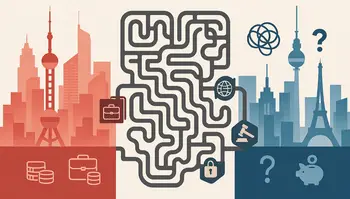
Living as a permanent resident in China offers incredible opportunities.
However, language barriers remain one of the biggest challenges for foreign nationals.
This guide explores the common obstacles and practical solutions to help you thrive in your new home.
Understanding the Reality of Language Barriers in China
China’s linguistic landscape is complex.
While Mandarin Chinese is the official language, regional dialects and cultural nuances create additional layers of communication challenges.
For permanent residents, these barriers extend beyond casual conversations to affect daily life, career growth, and social integration.
The Chinese government recognizes language proficiency as crucial for permanent residency applications.
A sufficient level of command of the Chinese language is required for those seeking long-term residency status.
This requirement reflects the practical reality that language skills are essential for successful integration into Chinese society.
Common Language Challenges Faced by Permanent Residents
Professional Communication Barriers
The workplace presents unique challenges for foreign permanent residents.
Business meetings, email correspondence, and professional documentation require specialized vocabulary and cultural understanding.
Many professionals struggle with:
- Technical terminology specific to their industry
- Formal business communication styles
- Understanding workplace hierarchy through language
- Participating effectively in group discussions
Healthcare and Legal Services
Medical appointments and legal procedures become particularly stressful when language barriers exist.
Healthcare providers may not speak English fluently, and medical terminology in Chinese differs significantly from Western medical language.
Legal documents, contracts, and government procedures require precise understanding of formal Chinese language structures.
Social Integration Challenges
Building meaningful relationships with local communities requires more than basic conversational skills.
Understanding cultural references, humor, and social etiquette through language creates deeper connections.
Many permanent residents find themselves isolated from local social circles due to communication limitations.
Educational System Navigation
For residents with children, understanding the Chinese educational system becomes crucial.
Parent-teacher conferences, school policies, and homework assistance require strong language skills.
The pressure to help children succeed academically while navigating language barriers creates additional stress for families.
The Impact of Language Proficiency on Daily Life
Language barriers affect every aspect of daily living in China. Simple tasks like grocery shopping, using public transportation, or seeking customer service become complex challenges.
Banking procedures, insurance claims, and government services often require forms and documentation in Chinese.
The emotional impact cannot be understated.
Many permanent residents experience frustration, anxiety, and feelings of helplessness when unable to communicate effectively.
This psychological barrier can prevent individuals from fully embracing their new life in China.
Strategic Approaches to Overcome Language Barriers
Formal Language Learning Programs
Structured education provides the foundation for long-term language success.
Universities, language schools, and cultural centers across China offer comprehensive Mandarin programs designed for foreign residents.
| Program Type | Duration | Cost Range (CNY) | Best For |
|---|---|---|---|
| University Programs | 1-2 years | 15,000-30,000 | Academic proficiency |
| Private Language Schools | 3-12 months | 8,000-20,000 | Flexible scheduling |
| Community Centers | 2-6 months | 2,000-8,000 | Budget-friendly options |
| Corporate Training | 1-6 months | 10,000-25,000 | Business focus |
HSK Test Preparation and Certification
The HSK (Chinese Proficiency Test) provides structured learning goals and official certification of language abilities.
HSK is the world’s third-largest language test brand after IELTS and TOEFL, making it globally recognized and valuable for both personal development and professional advancement.
The HSK system includes six levels, from basic survival Chinese to advanced academic proficiency:
- HSK 1-2: Basic daily communication (300-600 words)
- HSK 3-4: Intermediate conversation and workplace communication (600-1,200 words)
- HSK 5-6: Advanced academic and professional proficiency (2,500-5,000+ words)
Technology-Enhanced Learning Solutions
Modern technology offers unprecedented access to language learning resources.
Mobile applications, online platforms, and digital tools make learning convenient and engaging.
Top Language Learning Apps for Chinese
Based on current market analysis, several applications stand out for their effectiveness:
Comprehensive Learning Platforms:
- HelloChinese: Gamified learning with pronunciation feedback
- ChineseSkill: Interactive lessons focusing on practical communication
- Duolingo Chinese: Popular choice for beginners with bite-sized lessons
HSK-Specific Preparation:
- SuperTest is an intelligent platform of online learning for people who are preparing for the Chinese Proficiency Test
- HSK Online: Official practice tests and vocabulary exercises
- Pleco: Advanced dictionary with character recognition technology
Immersion Strategies for Daily Practice
Creating immersion experiences accelerates language acquisition.
Permanent residents have unique advantages in accessing authentic Chinese environments.
Active Immersion Techniques:
- Media Consumption: Watch Chinese TV shows, news programs, and movies with subtitles
- Social Media Engagement: Follow Chinese accounts on WeChat, Weibo, and other platforms
- Local News Reading: Start with simple local newspapers and gradually progress to national publications
- Podcast Listening: Choose topics of personal interest to maintain engagement
Community Engagement Methods:
- Join hobby groups and sports clubs
- Volunteer for local community organizations
- Attend cultural events and festivals
- Participate in neighborhood activities
Professional Language Support Services
Many permanent residents benefit from specialized language services tailored to their specific needs.
| Service Type | Applications | Average Cost (CNY/hour) |
|---|---|---|
| Translation Services | Documents, contracts | 150-300 |
| Interpretation | Medical, legal appointments | 200-500 |
| Business Tutoring | Professional communication | 100-250 |
| Academic Writing Support | Research, reports | 120-280 |
Cultural Context Learning
Language learning must include cultural understanding to achieve true communication effectiveness.
Chinese communication patterns, indirect communication styles, and social hierarchies significantly impact daily interactions.
Cultural Communication Elements:
- Guanxi (关系): Understanding relationship-based communication
- Face (面子): Navigating social dignity and respect in language
- Hierarchy Awareness: Using appropriate formal and informal language
- Regional Variations: Adapting to local dialects and customs
Sector-Specific Language Strategies
Healthcare Communication
Medical situations require specialized vocabulary and clear communication.
Permanent residents should prioritize learning:
- Body parts and symptoms vocabulary
- Common medical procedures and terminology
- Insurance and payment processes
- Emergency communication phrases
Practical Healthcare Language Tips:
- Prepare written symptom descriptions in Chinese
- Learn names of common medications
- Understand hospital department names
- Practice explaining medical history clearly
Business and Professional Development
Career advancement in China requires sophisticated language skills. Focus areas include:
- Industry-specific terminology
- Meeting participation language
- Email and document writing skills
- Networking and relationship-building communication
Legal and Administrative Procedures
Government interactions demand precise language understanding. Key areas include:
- Visa and residency renewal processes
- Tax filing and financial procedures
- Property and contract negotiations
- Banking and insurance communications
Building Long-Term Language Maintenance
Language acquisition requires ongoing practice and refinement.
Permanent residents must develop sustainable learning habits that fit their lifestyle and goals.
Creating Learning Routines
Consistency produces better results than intensive short-term efforts.
Successful language learners establish daily routines that include:
- Morning Practice: 15-30 minutes of vocabulary review
- Commute Learning: Audio lessons during transportation
- Evening Review: Daily reflection on new language encounters
- Weekend Intensive: Longer study sessions or cultural activities
Setting Realistic Goals
Effective language learning requires measurable, achievable objectives:
Short-term Goals (3-6 months):
- Master essential daily conversation topics
- Complete HSK 1-2 level certification
- Handle basic service interactions independently
Medium-term Goals (6-18 months):
- Achieve HSK 3-4 level proficiency
- Participate confidently in workplace meetings
- Understand news and media content
Long-term Goals (2-5 years):
- Reach HSK 5-6 advanced proficiency
- Engage in complex academic or professional discussions
- Contribute meaningfully to community activities
Overcoming Common Learning Obstacles
Motivation and Consistency Challenges
Language learning requires sustained effort over extended periods. Common obstacles include:
- Plateau Periods: Accepting temporary stagnation as normal
- Time Management: Integrating learning into busy schedules
- Progress Measurement: Celebrating small improvements regularly
Pronunciation and Tonal Difficulties
Chinese tonal pronunciation challenges many foreign learners. Effective strategies include:
- Technology Assistance: Use apps with pronunciation feedback
- Native Speaker Practice: Regular conversation with Chinese friends
- Recording Practice: Self-evaluation through audio recording
- Professional Coaching: Targeted pronunciation lessons
Character Recognition and Writing
Chinese characters present unique learning challenges.
Systematic approaches help:
- Radical Learning: Understanding character components and patterns
- Stroke Order Practice: Proper character writing techniques
- Digital Tools: Character recognition and writing applications
- Contextual Learning: Characters within meaningful sentences
Resources and Support Networks
Government and Educational Resources
Chinese government initiatives support foreign resident language learning:
- Confucius Institutes: Global network providing Chinese language and cultural education
- University Programs: Comprehensive degree and certificate programs
- Cultural Centers: Community-based learning opportunities
Online Communities and Support Groups
Digital platforms connect learners worldwide:
- WeChat Groups: Local learning communities and practice partners
- Reddit Communities: r/ChineseLanguage and related forums
- Language Exchange Platforms: HelloTalk, Tandem, and similar applications
Professional Development Organizations
Industry-specific organizations offer networking and language support:
- Chambers of Commerce: Business language and cultural training
- Professional Associations: Industry-specific terminology and communication
- Expat Communities: Peer support and shared experiences
Measuring Progress and Success
Assessment Tools and Benchmarks
Regular evaluation ensures steady progress toward language goals:
Formal Assessment Options:
- HSK Testing: Official proficiency certification
- University Placement Tests: Academic skill evaluation
- Corporate Assessment: Workplace communication evaluation
Informal Progress Indicators:
- Daily task completion without assistance
- Comfortable participation in social conversations
- Understanding news and entertainment media
- Contributing to workplace discussions effectively
Celebrating Milestones
Recognizing achievements maintains motivation throughout the learning journey:
- Certificate Achievements: HSK level completions
- Communication Breakthroughs: First successful complex conversation
- Cultural Participation: Active community engagement
- Professional Advancement: Career progress through improved communication
Future Considerations and Advanced Development
Specialized Language Skills
Advanced permanent residents may pursue specialized language competencies:
- Academic Chinese: Research and scholarly communication
- Technical Translation: Professional interpretation services
- Cultural Mediation: Cross-cultural communication expertise
- Teaching Qualifications: Chinese language instruction certification
Contributing to the Community
Language-proficient permanent residents often become valuable community resources:
- Volunteer Translation: Supporting fellow expatriates
- Cultural Bridge Building: Facilitating cross-cultural understanding
- Mentorship Programs: Guiding new arrivals through language challenges
- Professional Services: Offering language-related business services
Conclusion: Embracing the Language Learning Journey
Language barriers for permanent residents in China represent significant challenges but also tremendous opportunities for personal and professional growth.
Success requires commitment, strategic planning, and patience with the learning process.
The investment in Chinese language proficiency extends far beyond practical communication.
It opens doors to deeper cultural understanding, stronger professional relationships, and more meaningful community connections.
Each conversation mastered, each character learned, and each cultural nuance understood brings permanent residents closer to truly calling China home.
Remember that language learning is a marathon, not a sprint. Every small step forward contributes to long-term success.
The journey may be challenging, but the rewards of effective communication and cultural integration make the effort worthwhile.
With the right combination of formal education, technology tools, cultural immersion, and community support, any permanent resident can overcome language barriers and thrive in China.
The key is starting today, staying consistent, and celebrating progress along the way.


